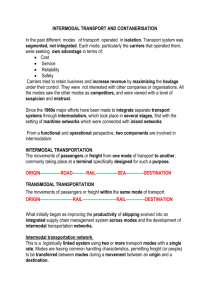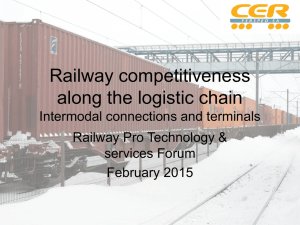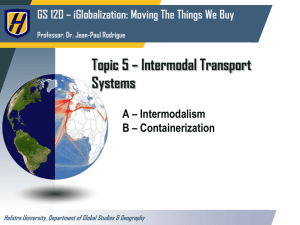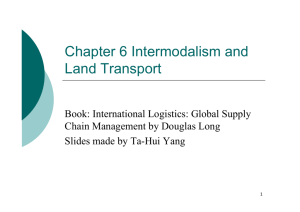Power Point slides for Chapter 6
advertisement
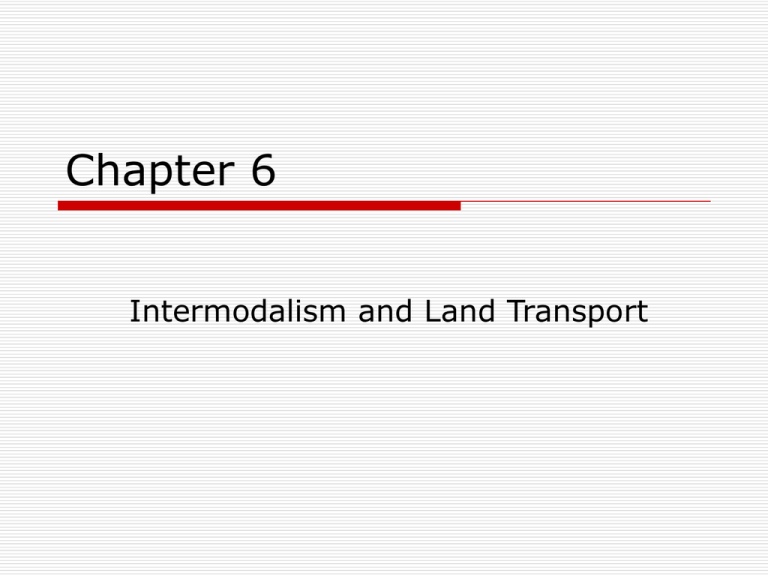
Chapter 6 Intermodalism and Land Transport Intermodalism One of the most important developments in the global business environment. The use of two or more modes of transportation in moving a shipment from origin to destination, primarily through the use of the “container”. There is a coordination between the modes. Container holding the cargo is exchanged between modes. The development of the container allowed the growth of intermodalism to be possible. Intermodalism The intermodal service combines the advantages of each mode used. For example air-truck intermodal transportation combines the advantages of the motor carrier’s accessibility and lower cost with the speed of the air carrier. Intermodalism A mode common to most forms of intermodal transportation is the motor carrier. The motor carrier's high degree of accessibility enables it to serve points that other modes are physically incapable of serving. Intermodalism If there is no coordination between the different modes, it is called multimodalism. Intermodalism Container (cargo container) is a big steel or aluminum box into which the freight is loaded. Improves the efficiency of interchange among modes. Reduces the potential for damage and theft. Both overall transit time and the transit time consistency of containerized intermodal shipments improve. All containers adhere to certain standards. Water container comes in two standard lengths: 20 feet and 40 feet. Beak-bulk cargo: moving cargo in their own boxes. Shipping Containers at Port of Elizabeth, New Jersey Intermodalism Benefits of using containers: Security: Harder to get into. Identified by only a serial number on the outside. Have seals put on the latches. Safety: Safer. The metal boxes are very strong. More weather resistant. Machines do handling, so it is safer for employees as well. Intermodalism Efficiency: Since each container is the same, special handling equipment is used. Can be handled quicker. Faster to take one intermodal container off a ship than any other containers. Speed: Speedier loading. More cargo can move through one port in a given amount of time. Takes more time to load and offload break-bulk cargo. Intermodal equipment Intermodal equipment is all standardized. There are five common standard lengths for containers, 20-ft, 40-ft, 45-ft, 48-ft, and 53-ft. The vast majority of containers are either 20 ft or 40 ft long. They are 8 ft (width) × 8 ft 6 in (height). Max. weight limit for 20’ is around 20,000 kg; for 40’ is 25,000 kg. Higher value and heavy cargo move in smaller lots, so 20s are more common. Most of the world’s containers have been built in Korea and Taiwan. More recently, the majority of new container construction has been occurring in China. Intermodal Equipment Air cargo does have intermodalism. Because pickup and delivery service is provided by truck. The container used in intermodal air shipments is not the standard 40-foot-long shape. It is smaller (usually under 20 feet), narrower than the standard 8-foot ocean container. Also prone to damage. There are about 20 different sizes of air cargo containers and pallets. Types of containers Dry: basic container. Open top: no top, so cargo can be laid down into the container. For over-height cargo. Flat rack: no top or sides, just the bottom and two ends. Platform: there is only the bottom. Refrigerated: a refrigeration unit-ideal cold storage for products such as: Meats, fish, vegetables, ice, plants, etc. Types of containers Live animals: horse carriers. Tank: to carry any liquid Bulk: there is a hole on the top so bulk products can be poured in. Containers are loaded to and unloaded from the ship by crane. TEU: container capacity is measured in twenty foot equivalent units (TEU)-the amount of cargo that would fit in a 20-foot intermodal container. Container rates are quoted by water carriers on a TEU basis. A container ship being loaded by a crane Managing Intermodal Transport The most important aspect of intermodalism is operating and management issues. Intermodalism requires cooperation and coordination among multiple companies. By working together, trucking companies, intermodal marketing companies, ocean steamship lines and railroads are providing a cost-effective, seamless, reliable, efficient, safe and environmentally friendly way to move freight from origin to destination. Shipments can be moved from a containership directly to a truck or a railroad and then delivered to its final destination. Throughout the process, intermodal facilitators, or third-party logistics providers, arrange for each piece of the move from pick up to drop off. Today, all parties in the supply chain use state-of-the-art technology to monitor shipments every step of the way. With real-time information, today's intermodal companies are keeping track of schedule changes and watching out for their customers' shipments so they don't have to. Intermodal traffic patterns are also important. A special infrastructure is required to handle intermodal cargo. In US there are 2 major lanes carrying intermodal cargo across the country. One is from Seattle to north, other from Los Angeles across the south. Roadway Transport One of the most important modes of transportation for freight movement in the 21st century. The public provision of highways has played a major roe in the development of the motor carrier because of the ubiquitous level of accessibility provided by the comprehensive US highway system. An important link in the intermodal chain. Links the ocean port or rail yard with the local origin or destination. Used for international trade as well. In Europe trucks are the main mode for international shipments since the rail system for cargo is not well developed. Roadway Transport Advantages of roadway transport: Greater accessibility Frequency of delivery and pickup Lower transit time Can be loaded quickly Not constrained to providing service over a fixed railway or waterway. Lowest entry costs. Roadway Transport Some of the trucking fleets are owned by shippers, some are independent, and some are owned by other carriers. Shipper-owned fleet: shippers owning their own trucks offer trucking services to other shippers for several reasons. Trucking is most influenced by local rules such as speed limits, registration, etc. The longer the trip the more legal jurisdictions it passes through. Roadway Transport Safety issues are very important (accidents). Trucks compete mostly with railroads, but rarely with other modes. Trucks are limited in the amount of cargo they can carry. The cargo-carrying capacity of these vehicles depends on the size (length) and the state maximum weight limits. Also there is a limit to the number of trailers that can be pulled at one time. A tractor-trailer combination with five axles is permitted in most states to haul a max of 80,000 pounds gross weight (110,000 pounds in Michigan). Roadway Transport Weight laws are for safety reasons. Roads can only stand a certain amount of weight. Trucks need to be registered somewhere. International trucking gives the carrier the option of where to register their trucks. Railroad Transport Best for large loads going long distances. Can handle large-volume movements of low-value commodities over long distances. No weight or volume restrictions. For loads over 30,000 pounds over distances exceeding 300 miles. Motor carriers are constrained by volume and weight. Pipelines compete directly with railroads, however they are restricted largely to the movements of liquid and gas. Historically trains in the US were privately owned and operated. Can handle almost any type of commodity. Have high fixed costs because they provide their own right–of-way and terminal facilities. Have very low variable costs. Restrictions on dimensions. Trains’ load cannot exceed tunnels’ and bridges’ dimensions. Liability for loss and damage is usually assumed by the railroads. Damage occurs because rail freight often goes through a rough trip due to vibrations and shocks. Railroad Transport Intermodalism is a large part of rail cargo. Containers may be placed on the back of the flatcar, called container-on-flatcar (COFC). If the whole trailer is placed on the flatcar, it is called trailer-on-flatcar (TOFC). TOFC is faster. Intermodal service (TOFC/COFC) has received renewed interest since 1980 and there has been a dramatic growth in the movement of such traffic by railroads. A flat car carrying two containers. Double-stack container train loaded with 53 ft containers. Railroad Transport Railroads are constrained by fixed right-of-ways and therefore provide differing degrees of service completeness. If both the shipper and receiver possess rail sidings, then door-to-door service can be provided. If no sidings are available, the movement of goods must be completed by some other mode. The railroad system provides a truly nationwide network of service. Each railroad serves a specific geographic region, and freight and equipment are exchanged at interchange points. Less dependable in keeping to a schedule. Slow. Competition is low. Railroads do not have the standardization. Rail gauge, the width of the track, differs from region to region. Inland shipping Includes rivers, canals, and lakes. It is mostly done at US Great Lakes, Mississippi River, Russia’s Great Rivers, China’s great rivers, and Europe's’ river systems. There is navigability issue. Rivers may be too shallow, or the depth changes with the shifting mud and sand. Seasonal variation also creates problem. Inland shipping companies have low fixed costs. Government pays for dredging and navigational aids. The vessels are more expensive than trucks. The biggest competition is railroads and pipelines. Pipelines The pipeline industry is unique in a number of important aspects, including the type of commodity hauled, ownership, and visibility. Pipelines are limited in the markets they serve, and very limited in the commodities they can haul. Pipelines are the only mode with no backhaul; products only move in one direction through the line. Pipelines are a very specialized carrier in that they transport a very limited variety of products: oil, natural gas, coal, and chemicals. With some exceptions, oil companies have been the owners of the oil pipelines. Some pipelines are joint ventures among two or more pipeline companies because of the high capital investment. Because of market-control tactics used by some oil companies, an important US Supreme Court ruling after WWII required pipelines to operate as common carriers, even if owned by an oil company. Pipelines are low-cost carriers when operated at capacity, but high levels of fixed cost because of the heavy investment necessary in infrastructure. Pipelines have a very good loss and damage record. Pipelines provide a warehousing function because their service is slow. Their dependability is another advantage. They are virtually unaffected by weather conditions and they very rarely have mechanical failures. They offer a fixed route of service and it cannot be easily extended to complete door-to-door service. They have limited geographic flexibility or accessibility. Druzhba pipeline
